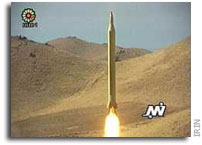Iran’s Sputnik

Courtesy of Aviation Week & Space Technology and Aviationnow.com. This article originally appeared in the 29 January 2007 edition.
Iran has just completed conversion of a powerful ballistic missile into a satellite launch vehicle. But the 25-30-ton rocket could be a wolf in sheep’s clothing to test longer-range Iranian missile technologies.
The Bush administration will likely view the vehicle as a rogue rocket developed in a cabal of Iran and North Korea.
The new launcher has recently been assembled and “will liftoff soon,” says Alaoddin Boroujerdi, chairman of the Iranian parliament’s National Security and Foreign Policy Commission.
Boroujerdi made the remarks this month during a speech before a group of religious students and clerics in the city of Qom near where Iran has conducted some of its ballistic missile tests.
If the Iranians are successful with the space launch program, it will have political and technological ramifications in both the U.S. and the Middle East (AW&ST Nov. 29, 2004, p. 36). “It would move the Iranians from the junior varsity into the big leagues,” one U.S. analyst said then.
“Ultimately, their space program aims to orbit reconnaissance satellites like Israel’s ‘Ofek,'” says Uzi Rubin, former head of the Israel Missile Defense Organization.
In a report for an Israeli think tank, the Jerusalem Center for Public Affairs, Rubin says Iran could adapt the satellite launcher into a longer-range intercontinental ballistic missile (ICBM). “Remember the impact on the U.S. of Russia’s launch of Sputnik,” his report says.
“In 2006, the Iranian political leadership seems to have moved beyond the needs of self-defense and is now talking about global power projection,” says Rubin, who oversaw development of the Israel Arrow anti-ballistic missile system.
The launcher could be one of two configurations: a derivation of the liquid- fueled 800-1,000-mi.-range Shahab-3 (see photo, left), or possibly a version of the solid-propellant 1,800-mi.-range Ghadar 110, of which the Iranians have released few if any photographs. A Shahab-3 or Ghadar 110 warhead fired from central Iran could reach Israel, Saudi Arabia, the entire Persian Gulf region and as far west as southern Turkey.
There are concerns in the intelligence community that space launch-related upgrades could eventually create an Iranian ICBM with a range of nearly 2,500 mi. that could reach as far west as Central Europe and well into Russia, China and India.
The U.S. Defense Intelligence Agency has told Congress that Iran in fact may be capable of developing a 3,000-mi.- range ICBM by 2015.
An Iranian satellite, and its new Iranian launcher, would also send White House National Security Council (NSC) space policy analysts back into high gear. NSC analysts have already been working overtime to sort out the implications of a Jan. 11 Chinese anti-satellite weapon test first reported by Aviation Week & Space Technology (AW&ST Jan. 22, p. 24). Like the Chinese Asat, the launch of an Iranian satellite would also reinforce strong calls from Congress and the Pentagon to bolster U.S. space situational awareness (see p. 28).
Although designed as a technology demonstrator, the planned small spacecraft would be a potent political and emotional symbol in the Middle East, if launched successfully. The new space launcher and ongoing missile development is also a visible symbol of close technological ties between the Iranian and North Korean missile programs, intelligence agencies agree. If the launcher is derived from the Shahab- 3, analysts at strategic policy think tank GlobalSecurity.org believe the new Iranian conversion could be a steppingstone to an Iranian clone of the North Korean Taepo Dong 2C/3 missile that failed in a launch attempt from North Korea last July 4.
A November 2006 Congressional Research Service (CRS) report reinforced concerns over Iranian and North Korean missile development ties. One of its authors, Kenneth Katzman, a CRS Middle East affairs specialist, notes that Israel’s military intelligence chief has information indicating that North Korea has shipped to Iran 18 1,500-mi.-range BM-25 ballistic missiles capable of carrying a nuclear warhead.
“Largely with foreign help, Iran is becoming self-sufficient in the production of ballistic missiles,” Katzman says. And he points out that the 2006 U.S. National Security Strategy Document states “The United States may face no greater challenge from a single country than Iran.”
GlobalSecurity.org analysts believe the new space launch vehicle, if based on the Shahab, could be composed of:
- A Shahab-3 first-stage core vehicle, possibly augmented by strap-on solid rocket boosters (see drawing p. 26);
- A Scud B second-stage using a SAM-2 propulsion system; and
- A third-stage solid rocket motor built in Iran using a Chinese design.
But, if the overall vehicle is a solidpropellant Ghadar, the configuration would look more like an Orbital Sciences Minotaur booster.
The preparation for and launch of an Iranian satellite “is something that needs to be watched closely,” said one U.S. government missile analyst also familiar with Iranian capabilities in an earlier report. “It could give rise to a number of scenarios.”
Israel, already under threat from the Shahab-3, is considering upgrades to its Arrow anti-ballistic missile system to keep pace with the higher reentry velocities of the more advanced Shahab-3 and Ghadar warheads. Iran’s new launch activity could also increase European interest in a European missile defense system.
U.S. and Israeli intelligence officials suggest that developing Shahab or Ghadar upgrades under the guise of a space launch vehicle could permit Iran to avoid the possible political and economic costs of missile testing.
Flight-testing of the Shahab has so far come out of the Shahroud (Emamshahr) region, flying south over Tabas tracking station. Satellite launchings would be expected to fly out over the Indian Ocean, says GlobalSecurity.org. Military launch tests have also come from the Qom region, part of the Dashte kavir (Salt Desert missile test range). More recently, a new facility near Dashte kavir and the Salt Desert missile test range has been suggested as the satellite launch site (see map p. 25).
Iran originally discussed the launch of up to two spacecraft on its own vehicle by early 2005, but those plans were delayed. The first space payload for the coming mission could be the 44-lb. Safir (Emissary) spacecraft carrying just a transmitter to confirm it achieved orbit demonstrating new booster capability.
An Iranian Mesbah (Lantern) spacecraft weighing about 132 lb. and carrying imaging and communications relay hardware could also be orbited soon, but on a Russian launcher. In October 2005, Russia launched the small Sina-1 spacecraft for Iran to gain satellite development experience.
Iran plans to launch five spacecraft in total by 2010, some of them on its own new booster, according to Iran’s official five-year plan.








